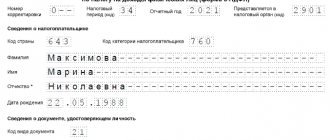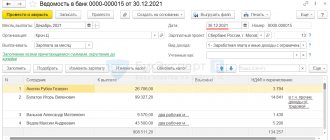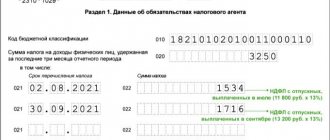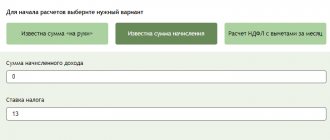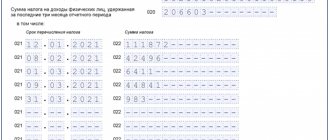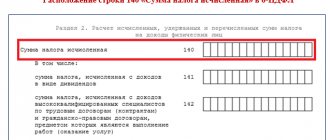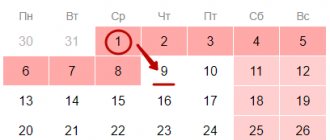Taxation of travel expenses: general rules
For an employee sent on a business trip, the employer is obliged to:
1. Pay the average salary for the period of the trip.
You can find out how it is calculated in the article “How the average monthly salary is calculated.”
Personal income tax on an average travel salary is calculated in the same way as on a regular salary while a person is at work. In general, according to the same principles, travel and regular salaries are reflected in tax reporting (but there are nuances here - we will look at them later in the article).
2. Pay for travel and accommodation where the person is sent.
Such expenses are not subject to tax, since they are not the employee’s income (Clause 3, Article 217 of the Tax Code of the Russian Federation). Information about them after a business trip is not reflected in 6-NDFL.
3. Issue daily allowances.
These are amounts that an employee can use for personal purposes - usually associated with paying for food, public transport and taxis within the locality to which he left.
You can find out more about the amount of daily allowance that an employee is entitled to receive on a business trip in the article “What is the amount of daily allowance for business trips.”
In the manner prescribed by law, daily allowances are subject to personal income tax and are subject to reflection in tax reporting.
Let's take a closer look at the features of calculating and reflecting in form 6-NDFL those components of travel payments that are subject to personal income tax - the average salary and partially daily allowances.
Reconciliation of 6-NDFL and 2-NDFL data
Also in the first group of the CC there are checks only of the annual report 6-NDFL, the data of which is compared with comparable information included in the reporting 2-NDFL, submitted only by year (clause 2 of Article 230 of the Tax Code of the Russian Federation) and having attribute 1 (i.e. . for those incomes in respect of which the tax agent performs all the necessary functions: accrual, withholding and transfers to the tax budget). Starting with reporting for 2022, 2-NDFL certificates are included in the 6-NDFL calculation and are called an appendix to it. That is, this comparison refers to intra-document ones.
Read more about the rules for issuing this certificate in the article “How to correctly issue a 2-NDFL certificate .
This group of CSs consists of the following ratios:
- 1.5 - the total amount of accrued income (p. 110) for each of the applied rates (p. 100) must coincide with the total amount of income at a similar rate for 2-NDFL reporting;
- 1.8 - the amount of income in the form of dividends (p. 111) must coincide with the same amount shown in all 2-NDFL certificates under code 1010;
- 1.9 - the tax calculated at the appropriate rate (p. 100) (p. 140) must be equal to the total tax amount for the same rate for all 2-NDFL certificates;
- 1.10 - information on the amount of unwithheld tax (p. 170) must correspond to the total amount of the same indicators for all 2-NDFL certificates;
- 1.18—data on the number of persons who received income (p. 120) must coincide with the number of 2-NDFL certificates submitted to the Federal Tax Service.
If the Federal Tax Service discovers discrepancies between 2-NDFL and 6-NDFL, it will require explanations for the discrepancies . At the same time, the difference in 6-NDFL and 2-NDFL for 2022 by 1 ruble is not considered critical.
In addition, the accrued wages are compared with the minimum wage and with the average wage for the industry. If the accrued salary is below the specified values, then the tax authorities may ask for clarification.
How to check 6-NDFL for errors, see here.
Salary on a business trip: payment terms
Having information about the timing of transferring taxable payments to an individual is the most important condition for correctly filling out Form 6-NDFL.
The travel salary (which is calculated, as we noted above, on the basis of average earnings) is paid to the employee in the same time frame as the main salary, since it is one of the options for remuneration, part of the salary as such (Articles 167, 139 of the Labor Code of the Russian Federation) .
If the salary is transferred to the employee’s card, then, as a rule, there are no practical difficulties in meeting the deadlines for its payment (an exception is if, for example, in the locality where the business traveler went, there are no ATMs and acquiring services due to the fact that it is remote from communication networks).
If salaries are traditionally issued through the organization’s cash desk (or there are noted technical difficulties in using the card), then the employer should use available alternatives so that the employee on a business trip receives his salary on time. In this case, federal legislation proposes making a money transfer at the expense of the employer (clause 11 of the Regulations according to Decree of the Government of Russia dated October 13, 2008 No. 749).
In practice, the travel portion of the salary can be included in the calculation:
- advance payment (salaries for the first half month);
- basic salary (for the second half of the month).
Depending on which part of the salary includes its “travel” component, the procedure for reflecting this component in 6-NDFL is determined. Let's look at the options here.
How to reflect travel salary in 6-NDFL
Wages are recognized as income of an individual as of the last day of the month for which they are calculated. And the tax on it is withheld from the next nearest payment (usually until the 15th of the next month).
That is, personal income tax on the travel component of the salary will be:
- Calculated (based on the recognition of an individual’s income as received) - at the end of the month (regardless of whether travel allowances are included in the advance or the basic salary).
- Withheld - simultaneously with the payment of the main part of the salary.
- Transferred to the budget - the next day after deduction.
Thus, the 6-NDFL report shows (in terms of the amount of average earnings during the business trip and the personal income tax accrued on it):
1. In section 2 of the report:
- on pages 110 and 112 - the amount of travel allowances;
- on pages 140 and 160 - the tax calculated and withheld from this amount.
2. In section 1 of the report:
- on page 021 - the next working day after the day of dismissal;
- on page 022 - the amount of personal income tax withheld.
Next, we will tell you how to reflect travel payments in terms of daily allowances in 6-NDFL.
Important nuances
Equality of indicators for calculated and withheld tax is not mandatory. If in 6-NDFL the amount of tax withheld is greater than calculated, this is not considered an error. This position is substantiated by a letter issued by the Federal Tax Service on May 16, 2016 under No. BS-4-11/8609. The reason for the discrepancies in the total values in different approaches to determining the date of formation of the accrued tax and the withheld tax for the tax agent.
If questions arise regarding differences in indicators, the tax agent draws up an explanatory note with the regulatory authority. When in 6-NDFL the amount of calculated tax is less than the withheld tax or vice versa, the accountant must double-check that the form is filled out correctly. Provided that no errors have been identified, it is necessary to prepare a documented justification for the reasons for the nonconformity.
Taxation of excess daily allowances: general points
Daily allowances are not taxed within the limits of amounts per employee (clause 3 of Article 217 of the Tax Code of the Russian Federation):
- 700 rubles per day - for business trips around Russia;
- 2500 rubles per day - for foreign business trips.
Amounts falling within the specified limit should not be reflected in any way in the 6-NDFL report.
This is the fundamental difference between daily allowances and tax deductions, which, in cases provided for by law, reducing personal income tax to zero, are nevertheless subject to reflection in reporting.
Taxable daily allowances, like wages, are subject to inclusion in tax reporting. In this case, daily allowances are recognized as income at the end of the month in which the accounting department approves the advance report of the employee returning from a business trip (subclause 6, clause 1, article 223 of the Tax Code of the Russian Federation).
The employee submits the report within 3 days after returning to work. The deadline for approval of the accepted report is determined by the employer himself (clause 6.3 of Bank of Russia Directive No. 3210-U dated March 11, 2014). By analogy with salaries, tax on excess daily allowances, which are recognized as income at the end of the month, is withheld from the next next salary (in practice, from one of its parts, an advance or the principal amount). It doesn’t matter when the employee actually received the daily allowance; the moment they were received is not reflected in the reporting in any way and does not affect the procedure for its preparation.
Let's look at an example of how travel allowances are recorded in 6-NDFL if they are presented in excess of the limit.
Errors that the Federal Tax Service drew attention to
For reporting for 9 months of 2022, the tax service issued two clarifications about errors that are most often found in 6-NDFL.
The form for calculating the amounts of personal income tax calculated and withheld by the tax agent, the procedure for filling it out and submitting it were approved by Order of the Federal Tax Service of Russia dated October 15, 2020 No. ED-7-11/ [email protected] .
6-NDFL is filled out based on accounting data:
- on income accrued and paid to employees, on income accrued and paid to employees,
- about the tax deductions provided,
- on calculated and withheld personal income tax according to tax registers.
How to reflect above-limit daily allowances in 6-NDFL: example
Ivanov A.A. On July 8, 2022, he went on a business trip for 15 days, receiving a daily allowance in the amount of 15,000 rubles. Upon his return, he prepared an advance report and submitted it to the accounting department on July 23. For July, Ivanov received his salary on August 6.
Accountants will need:
1. Calculate the taxable amount of excess daily allowance.
It's simple: divide 15,000 by 15 days of business trip - it turns out 1,000 rubles per day. Of these, 300 rubles. (1,000 – 700) is the employee’s taxable income. Total taxable income for a business trip is 4,500 rubles (300 × 15 days).
2. Reflect in the 6-NDFL report for 9 months (in terms of taxable amounts for excess daily allowance):
1. In section 2:
- in columns 110 and 112 - 4,500 rubles of income;
- in columns 140 and 160 - 585 rubles each (calculated and withheld tax).
2. In section 1:
- in column 021 - 08/09/2021 (personal income tax is transferred to the budget);
- in column 022 - 585 rubles (personal income tax on daily allowance).
The terms we considered for calculating and reflecting travel payments in the 6-NDFL report are determined in relation to the status of an individual as an employee of an organization. But what about these procedures if, at the time the daily allowance is recognized as received and taxable income, the employee is fired? This scenario can be classified as a special one - let’s get acquainted with the accounting procedure in this case.
Learn more about filling out forms
Having determined the correctness of calculating the amount of the tax burden, we will consider in more detail the principle of filling out personal income tax reporting forms.
How to fill out a 2-NDFL certificate: with or without kopecks?
In the columns of the 2-NDFL certificate, all amounts relating to the income tax of a particular individual should be entered in full rubles in the corresponding lines of the certificate. All other indicators (income, tax base, deductions) are reflected in rubles and kopecks.
How are indicators formed in 3-NDFL: with or without kopecks?
The principle of entering total values into the lines of the 3-NDFL declaration depends on the type of indicators. Amounts of accrued tax, advance payments, total amounts of tax to be paid or refunded, etc. (i.e. everything related to tax) is indicated in whole rubles. Other indicators are reflected in rubles and kopecks.
Please note that the filling procedure, approved. Order of the Federal Tax Service No. ММВ-7-11/ [email protected] dated 10/03/2018 provides for the reflection of tax on income that was received by a tax agent resident of the Russian Federation outside Russia (appendix to section 2). In such situations, the amount of income received in a foreign state and the tax on it paid, respectively, to a foreign state in the 3-NDFL declaration is indicated in two versions - in the currency of the state where the declared income was received, and converted at the Central Bank rate - in rubles and kopecks.
Special scenarios: reporting per diem upon dismissal of an employee
For clarity, let's consider another example.
Ivanov A.A. submitted a report on the business trip on July 5, 2022, then, after working in the company until the 16th, he wrote a letter of resignation. The parties agreed to terminate labor relations on July 19 and make all payments.
The question arises - how to withhold personal income tax (and reflect it in reporting) if the day on which the excess daily allowance is recognized as income - July 31, 2022 - comes later than the day the employee is dismissed?
In this case, personal income tax is subject to withholding simultaneously with calculations upon dismissal. In form 6-NDFL the following are recorded (in section 1):
- in column 022 - 07/20/2021 (date of transfer of tax to the budget).
Many lines 110 in one 6-NDFL
If during the reporting/tax period the tax agent paid income to individuals at different rates, one 6-NDFL may contain several lines 110. In such situations, several sections 1 and 2 must be filled out in the calculation, indicating the corresponding tax rate and the indicators formed in accordance with it , including line 110 (clause 2 of the Federal Tax Service letter dated December 1, 2020 No. BS-4-11/ [email protected] ).
For example, the majority of income of individuals ─ tax residents is taxed at a rate of 13% (salary, bonus, remuneration on GPC income, etc.). A rate of 15% is applied to the income of individuals in the case when the amounts taxed at the rate of 13%, taking into account deductions, exceed 5 million rubles. (Subclause 1, 3.1 of Article 224 of the Tax Code of the Russian Federation), a rate of 30% ─ on the income of individuals ─ non-residents of the Russian Federation, and a rate of 35% ─ upon receipt of winnings (prizes) by residents of the Russian Federation.
Example
Polymer Materials LLC has two employees: general director Zolotov A.E. and chief accountant Tikhomirova E.V. Each salary is 3,000,000 rubles. per month, which was paid in the 1st quarter of 2022 in the following order:
- February 6 ─ for January;
- March 6 ─ for February;
- April 6 ─ for March.
In addition to the salary due on March 6, everyone was paid dividends in the amount of RUB 7,000,000.
When filling out 6-personal income tax for the 1st quarter, the chief accountant created two sections 1 and two sections 2, since two personal income tax rates are applied to the indicated income: 13 and 15%.
The March salary paid in April will be reflected in section 1 of 6-NDFL for the six months. There is no reason to reflect it in the calculation for the 1st quarter, since the deadline for paying personal income tax has not yet arrived.

